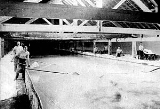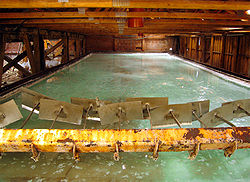
Open pan salt making
Encyclopedia
In Europe
virtually all domestic salt is obtained by solution mining of underground salt formations although some is still obtained by the solar evaporation of sea water. Salt is extracted from the Brine
using vacuum pans, where brine is heated in a partial vacuum
in order to lower the boiling point. In the past salt has been extracted by heating the brine in pans operating at normal atmospheric pressure, known as open pans.
. Later examples were small (3 ft square) pans made from lead
using wood as a fuel. After the middle ages
the pans started to be made from iron
, firstly in pans 7 ft (2.1 m) by 8 ft (2.4 m). Gradually the pans increased in size until 'common' salt pans 20 ft (6.1 m) wide and 30 ft long were the norm. The change from lead to iron coincided with a change from wood to coal for the purpose of heating the brine. Brine would be pumped into the pans, and concentrated by the heat of the fire burning underneath. As crystals of salt formed these would be raked out and more brine added.

, England
.
Europe
Europe is, by convention, one of the world's seven continents. Comprising the westernmost peninsula of Eurasia, Europe is generally 'divided' from Asia to its east by the watershed divides of the Ural and Caucasus Mountains, the Ural River, the Caspian and Black Seas, and the waterways connecting...
virtually all domestic salt is obtained by solution mining of underground salt formations although some is still obtained by the solar evaporation of sea water. Salt is extracted from the Brine
Brine
Brine is water, saturated or nearly saturated with salt .Brine is used to preserve vegetables, fruit, fish, and meat, in a process known as brining . Brine is also commonly used to age Halloumi and Feta cheeses, or for pickling foodstuffs, as a means of preserving them...
using vacuum pans, where brine is heated in a partial vacuum
Vacuum
In everyday usage, vacuum is a volume of space that is essentially empty of matter, such that its gaseous pressure is much less than atmospheric pressure. The word comes from the Latin term for "empty". A perfect vacuum would be one with no particles in it at all, which is impossible to achieve in...
in order to lower the boiling point. In the past salt has been extracted by heating the brine in pans operating at normal atmospheric pressure, known as open pans.
History of open pan salt extraction
The earliest examples of pans used in the solution mining of salt date back to prehistoric times and the pans were made of ceramics known as briquetageBriquetage
Briquetage is the name for a coarse ceramic material used to make evaporation vessels and supporting pillars used in extracting salt from seawater. Thick-walled saltpans were filled with saltwater and heated from below until the water had boiled away and salt was left behind...
. Later examples were small (3 ft square) pans made from lead
Lead
Lead is a main-group element in the carbon group with the symbol Pb and atomic number 82. Lead is a soft, malleable poor metal. It is also counted as one of the heavy metals. Metallic lead has a bluish-white color after being freshly cut, but it soon tarnishes to a dull grayish color when exposed...
using wood as a fuel. After the middle ages
Middle Ages
The Middle Ages is a periodization of European history from the 5th century to the 15th century. The Middle Ages follows the fall of the Western Roman Empire in 476 and precedes the Early Modern Era. It is the middle period of a three-period division of Western history: Classic, Medieval and Modern...
the pans started to be made from iron
Iron
Iron is a chemical element with the symbol Fe and atomic number 26. It is a metal in the first transition series. It is the most common element forming the planet Earth as a whole, forming much of Earth's outer and inner core. It is the fourth most common element in the Earth's crust...
, firstly in pans 7 ft (2.1 m) by 8 ft (2.4 m). Gradually the pans increased in size until 'common' salt pans 20 ft (6.1 m) wide and 30 ft long were the norm. The change from lead to iron coincided with a change from wood to coal for the purpose of heating the brine. Brine would be pumped into the pans, and concentrated by the heat of the fire burning underneath. As crystals of salt formed these would be raked out and more brine added.

Occupations in an open pan salt works
The following are historical names given to occupations in open pan salt works, primarily in CheshireCheshire
Cheshire is a ceremonial county in North West England. Cheshire's county town is the city of Chester, although its largest town is Warrington. Other major towns include Widnes, Congleton, Crewe, Ellesmere Port, Runcorn, Macclesfield, Winsford, Northwich, and Wilmslow...
, England
England
England is a country that is part of the United Kingdom. It shares land borders with Scotland to the north and Wales to the west; the Irish Sea is to the north west, the Celtic Sea to the south west, with the North Sea to the east and the English Channel to the south separating it from continental...
.
- Lumpman: A lumpman would work on pans that made fine salt crystals, which were known as 'fine pans' or 'lump pans'. The quality of the salt depended on the state of the fires which crystallised the salt by forcing off the water. Therefore each pan had its own individual furnace and chimney, which the lumpman was responsible for controlling. Wooden moulds were filled with salt crystals from the pans to produce a hard block (lump) of fine salt. Lumpmen were paid piecework, and would start at 3 or 4 in the morning, and could expect to work 12-16 hour days.
- Waller: A waller would be under the charge of the lumpman, and was responsible for the initial draining of the salt. Salt was drained by being raked to the side of the pans, and then transferred using skimmers onto the hurdle boards (walkways) around the pans. A waller is an ancient name for a saltmaker. He would have been hired on a daily basis.
- Fireman: In addition to the fine pans there were other 'common pans', used to make coarser salt. Because the production of common salt required slower burning fires, it was possible for a single fireman to have charge of several common pans, which could be up to 80 feet (24.4 m) long.
- Pan-smith: This was originally the name given to the man who made the salt-making pans.
See also
- Grainer process
- Seawater GreenhouseSeawater GreenhouseThe Seawater Greenhouse is a technology that enables the growth of crops in arid regions, using a greenhouse structure, seawater and solar energy...
- Alberger processAlberger processThe Alberger process is a method of producing salt.It involves mechanical evaporation, and uses an open evaporating pan and steam energy. It results in a unique, three-dimensional flake salt of extremely light bulk density. It is highly prized in the fast food industry, due to its low sodium and...
- Salt in CheshireSalt in CheshireCheshire is a county in North West England. Rock salt was laid down in this region some 220 million years ago, during the Triassic period. Seawater moved inland from an open sea, creating a chain of shallow salt marshes across what is today the Cheshire basin...
- History of salt in MiddlewichHistory of salt in MiddlewichMiddlewich, a town in northwest England, lies on the confluence of three rivers – the Dane, the Croco and the Wheelock. Most importantly for the history of salt making, it also lies on the site of a prehistoric brine spring....
- Lion Salt WorksLion Salt WorksThe Lion Salt Works is the last remaining open pan saltworks in Cheshire, England. It closed as a works in 1986 and is now preserved as a museum...
- Salt Museum, NorthwichSalt Museum, NorthwichThe Weaver Hall Museum and Workhouse, Northwich, Cheshire, records the social, cultural and industrial history of west Cheshire. It was formerly known as the Salt Museum, reflecting its earlier focus on the history of salt extraction, a local industry dating back to Roman times...
- Saline Luisenhall

